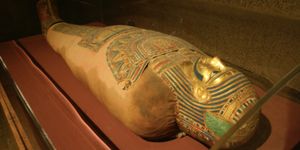Monkeys, not humans, made the oldest stone tools in Brazil
Researchers have known for quite sometime that non-human primates made and used tools. In fact, using tools was once one of the defining characteristics of what it means to be human. But, in the 1960s, Jane Goodall discovered chimpanzees using stone tools, prompting world-renowned anthropologist Louis Leakey to say that we must either change our definition of human to include chimpanzees, or change our definition of tool.
Since that discovery, it has been reported that many non-human animals, including apes, monkeys, crows, dolphins, and perhaps even octopuses use tools in some capacity. Capuchins—small, clever monkeys native to South America whom you may recognize as Ross’s pet in Friends—are the only animal aside from humans that have been observed making stone tools, specifically. In other words, they are the only non-human animal who has been observed banging rocks together to break them. Admittedly, capuchins use these tools much differently than humans do—humans are usually after the flakes that fall from the broken rocks since they are often very sharp. The capuchins do not seem to care about the flakes, and have been observed licking the surface of the stone, maybe for the minerals.
A 2016 paper found that wild capuchin stone tool use dates back 600 to 700 years, which would mean it’s the oldest non-human stone tool use outside of Africa. But, as it turns out, capuchin stone tool use might be even older.
A team of researchers from the Instituto Nacional de Antropología y Pensamiento Latinoamerican in Argentina have found that stone tools from a Pleistocene-era site in Brazil were most likely the work of capuchins, not humans. The excavation was at Pedra Furada in Piauí, Brazil where stone tools made from quartzite and quartz cobbles were found. These artifacts seem to be similar to the stone tools made by capuchins at the Serra de Capivara National Park in Brazil. Previous work found that capuchins created flakes when banging rocks together to complete a variety of different tasks, and that the flakes are similar to those made by humans.
The idea that maybe monkeys made the tools at Pedra Furada has been raised by several other scientists and when the flakes are combined with the fact that there is a lack of evidence for human habitation at the site (e.g., no concrete trace of dietary remains, no hearths) there is support for the idea that monkeys made the tools. Results from the most recent paper provide solid evidence for the fact that capuchins made the tools. In an interview with the National Scientific and Technical Research Council of Argentina, one of the study’s author says, “Our study shows that the tools from Pedra Furada and other nearby sites in Brazil were nothing more than the product of capuchin monkeys breaking nuts and rocks some 50,000 years before the present.”
Aside for major implications in regards to animal behavior and tool use, the study also has wide implications for human settlement in the Americas. The study suggests that human settlement is more recent, and may be in line with the Clovis first theory (stating that glaciers prevented settling of the Americas before 14,000 years ago), questioning some of the work stating humans migrated and settled in the Americas before 14,000 years ago.
Sources: Through a Window: My Thirty Years with the Chimpanzees of Gombe, The Conversation, National Geographic, Wired, Current Biology, Scientific American, The Holocene, PaleoAmerica, National Scientific and Technical Research Council, Artnet, Science Alert









